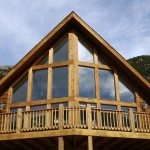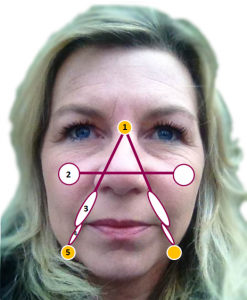The Aurora Lift forms the basis of our advanced facial rejuvenation training – both for our team at Aurora Clinics, and our delegates at Cosmetic Courses.
It’s used by our trainers in their own clinics, and to date remains the best method our Clinical Director Adrian Richards has found to achieve natural results from non-surgical treatment.
It gives us a blueprint for treatment, helping us focus on the important areas to achieve the most natural and long-lasting facial rejuvenation.
So what is the Aurora Lift?
The Aurora Lift essentially involves looking at the face as an A-frame (see picture below) and treating it accordingly, using a combination of Botox and facial fillers.
 With age, facial volume migrates gradually southwards. This changes the shape of the face from the inverted triangle of youth, with its apex facing down, to the traditional triangle of middle age and beyond, with its apex facing up.
With age, facial volume migrates gradually southwards. This changes the shape of the face from the inverted triangle of youth, with its apex facing down, to the traditional triangle of middle age and beyond, with its apex facing up.
Using the A-frame concept, we’re able to focus on distinct treatment areas to effectively counter this ageing triangle inversion.
It involves subdividing the face into areas which lie along the limbs of an extended ‘A’. To achieve the most harmonious facial rejuvenation, we ask our practitioners and delegates to focus on these areas.
 The A-frame Zones for Facial Rejuvenation
The A-frame Zones for Facial Rejuvenation
- Glabella
- Cheeks
- Nasolabial Folds
- Marionette Lines
- Pre Jowl Salcus
Glabella
The apex of the A is located over the glabella. This is treated in most cases with our standard 5 point Botulinum toxin pattern. This involves a single sub-cutaneous injection over procerus and 2 into either corrugator.
We find that sub-cutaneous placement is more comfortable for the patient, produces less bruising and trauma and reduces the risk of toxin diffusion into orbit which can result in weakness of the eye muscles.
Cheeks
Working downwards, the next focus areas lie at the ends of the transverse limb of the A-frame – the cheeks. Where possible, we ask clients to bring in old photos so we can assess their volume changes over time. Our aim is to restore their youthful volume, not add more than they had as this can produce an unnatural appearance.
We restore lost volume with filler within each of the fat compartments of the cheeks. Our preferred method of delivery is with a blunt-ended cannula rather than a needle, as we believe it gives us more control whilst minimising trauma.
Nasolabial Folds and Marionette Lines
Our next focus areas, along the limbs of the A-frame, are the nasolabial folds and marionette lines. Again our preference is a cannula, as there is only one point of entry and less trauma as a result.
Care must be taken not to add too much volume here, as excess volume in the lower face can age rather than rejuvenate.
Most patients treated with the Aurora Lift will also have toxin treatment to the depressor anguli oris muscle to upturn the mouth and reduce the amount of dermal filler needed.
Pre Jowl Sulcus
Finally, the base of the A-frame lies below the jowls. Again, our preference here is to use a moderate dose of toxin in this region to reduce the downward pull of the platysma on the jowls.
Find out more
At Cosmetic Courses, we teach the Aurora Lift at our bespoke advanced training sessions. Attend one of these hands-on training days and you’ll learn the principles of the A-frame approach, and how best to apply them to achieve harmonious pan facial rejuvenation for your clients.
For more information or to book a place on our advanced course, please contact the team on 01844 318317 or email [email protected].








